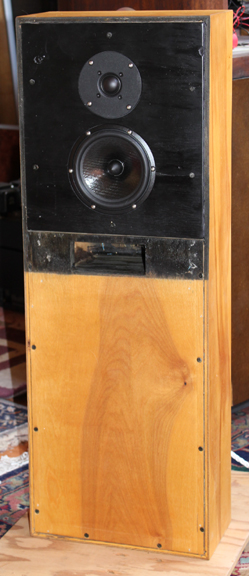|
Resurrecting the DALINE Loudspeaker: The SEAS DALINE
Tip #80 by Dick Olsher
 In 1975 Robert Fris authored an article in the British HiFi News & Record Review Magazine (download at: www.tech-diy.com) describing two versions of his DALINE loudspeaker based on the KEF B110 5-inch woofer. DALINE was his chosen acronym, standing for Decoupled Anti Resonant Line, which in reality is a variation on the transmission line theme consisting of a front chamber coupled to a fairly short line. The article created quite a buzz on both sides of the Atlantic, especially in view of its reasonable size, cost, and claimed bass extension to 20 Hz. That was enough to get me interested in the early 80s, and with help from Roger, my expert woodworking buddy, we built a two-way Focal version of the DALINE using a pair of 5N401 woofers per side. We both liked the finished speaker, though bass extension went no deeper than about 50 Hz, even when mounted on or against a wall to obtain the optimal 2pi loading required by the DALINE. In 1975 Robert Fris authored an article in the British HiFi News & Record Review Magazine (download at: www.tech-diy.com) describing two versions of his DALINE loudspeaker based on the KEF B110 5-inch woofer. DALINE was his chosen acronym, standing for Decoupled Anti Resonant Line, which in reality is a variation on the transmission line theme consisting of a front chamber coupled to a fairly short line. The article created quite a buzz on both sides of the Atlantic, especially in view of its reasonable size, cost, and claimed bass extension to 20 Hz. That was enough to get me interested in the early 80s, and with help from Roger, my expert woodworking buddy, we built a two-way Focal version of the DALINE using a pair of 5N401 woofers per side. We both liked the finished speaker, though bass extension went no deeper than about 50 Hz, even when mounted on or against a wall to obtain the optimal 2pi loading required by the DALINE.
Roger went on to build several pairs, all of which included a front chamber filled with long-hair wool. He lived happily ever after with the Focal DALINE for the next 25 years, until some of the woofers started to fail. Sadly, the Focal 5N401 is no longer in production and neither are there any re-coning kits to be had. The decision was made therefore to redesign the speaker using modern drivers while staying as faithful as possible to the original B110 DALINE. While searching for woofers that would capture the essential parameters of the B110, I was excited and surprised to discover the SEAS U16RCY/P (H1520-08) 5-inch woofer, featuring their new Curv woven polypropylene cone and a radially reinforced low-loss rubber surround, which is intended specifically for bass reflex and transmission line designs. Its TS parameters are exceptionally close to those of the B110, with a free air resonance of 36 Hz, a VAS of 25 liters and a Qts of 0.32. The SEAS 27TDC (H1149) was chosen to complement the woofer on the basis of its low resonance frequency, smooth response and linearity without any added magnetic fluid damping.
I evaluated several crossover options, but the one that stood out sonically is shown below. It’s an asymmetric type at a frequency of 2.5 kHz with a second-order high-pass network for the tweeter and a first-order low-pass network for the woofer. For the past six years I’ve been experimenting with these type of filters, including second order low-pass coupled to fourth-order high-pass networks, as a means of incorporating time delay to align the tweeter’s acoustic center with that of the woofer.
The impedance curve of the SEAS DALINE is shown in Figure 2. The impedance magnitude is given by the green trace and its twin peak structure below 100 Hz is seen to be similar to that of a bass reflex design. However, the minimum between these peaks at a frequency of about 48 Hz is caused by the transmission line’s quarter wave length resonance which acts to reduce cone motion.
The frequency response for both channels is shown in Figure 3, measured in-room on the tweeter axis, free-standing, at a distance of about 5-feet from the front baffle. The plots include room modes, and since the measurements were not performed on a wall interface, the baffle step effect is most noticeable below a frequency of about 300 Hz. This is the range that should fill in when the DALINE is located next to a wall interface. Expect useful in-room bass extension to about 40 Hz.
In my estimation, the new SEAS DALINE is sonically head and shoulders above the old FOCAL design. It manages to sound present without being bright. There’s plenty of detail to behold within a deep and cohesive soundstage. This DALINE boogies along with a tight and tuneful bass range. Midrange clarity is generally excellent, and I’m particularly pleased with the driver integration which is very felicitous of female voice.
|